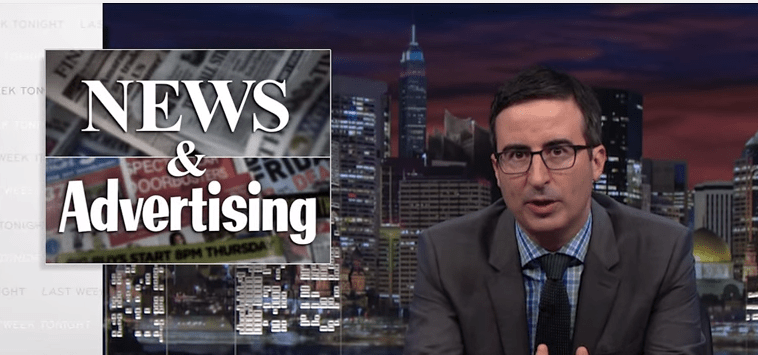
Edward Kim is cofunder and CEO of SimpleReach, an analytics service for brand content.
First it was Girls, and now Last Week Tonight with John Oliver. HBO seems to have a strange obsession with native advertising.
John Oliver’s 10-minute segment on Sunday evening has created quite a bit of chatter in the industry, and, I’m sure, a little bit of introspection as well. While I agree with many of the points Oliver makes around the need to be transparent with readers, I fear the segment may inadvertently cause marketers and publishers to write off what should be a broader conversation: the role of native advertising in a changing media landscape.
Over the last decade, pageviews have gotten a bad name as a result of banner ads. But that’s what happens when an ad format and the product it supports don’t share the same incentive structure. Banner ads are a very literal translation of print ads from an analog world to a digital world. In the analog world, supply was limited: a magazine or daily newspaper could only have so many pages. When digital media introduced unlimited supply, negative things started to happen. The arrival of 100-page slideshows is an extreme result of these misaligned incentives – because revenue for a digital publisher became completely dependent on volume, it made sense to optimize for short content and quick clicks. The trend continued until the pendulum shifted too far the other way, with an oversupply of content and falling CPMs. But by that point, publishers were accustomed to chasing volume for increased revenue, and there was no going back.
It takes a lot to realign a $10-plus billion ecosystem. The rise of programmatic buying, combined with the shift to mobile consumption (and the associated lower overall CPMs), were exactly the type of shockwave necessary for publishers to find a different approach. An entirely new class of media publishers is now emerging, and existing publishers are scrambling to reinvent themselves.
I believe we’ll look back at this time many years from now and realize that native advertising, instead of dooming modern media, actually helped save the quality of digital content.
The banner ad ties the worth of any given article to the views it generates. In a CPM-compressed environment, a great article might only be worth $10. The beauty of native advertising is that it removes misaligned incentives, and separates the editorial article from the ad product. No longer is a publisher’s revenue tied to any one article. Rather, a publisher’s value reflects the library of content it produces.
Ad position: web_incontent_pos1
When a healthcare brand wants to run a native campaign to promote thought leadership, for example, its primary concern isn’t the traffic volume of the partner site. Instead, the brand seeks to partner with whichever publisher has created the highest-quality content in the space. With native advertising, the revenue incentives are aligned so that great content wins and attracts ad dollars. In absolute terms, the value brands are ascribing to quality content is higher than we’ve seen in a very long time.
Even a year and a half later, Scientology on The Atlantic is still the most often cited example of native advertising and serves as the chief argument against the format. I take a different view. I see a 150-year-old media company that creates high-quality content and was starving for revenue and a way to sustain itself. In the last few years, The Atlantic has built a native advertising program that represents the majority of its advertising revenue and allows its editorial staff to continue creating content without sacrificing quality.
We should not be an industry that harps on a single mistake and uses that mistake to criticize what is otherwise an incredible success. We shouldn’t dismiss a format outright that holds promise and has already proven itself as a resource to subsidize quality journalism.
While native advertising is far from perfect, it’s still in its early days, and innovation is rarely a clean process. Mistakes will be made and lessons learned on the way to developing standards and best practices. Ultimately, trust is a publisher’s most valuable asset. To be successful in the long term, native advertising must secure a firm position in which the relationship between publisher and reader is clear and uncompromising. An opportunity of this magnitude will inherently present its challenges, but nothing that our industry can’t overcome.
More in Media

NewFronts Briefing: Samsung, Condé Nast, Roku focus presentations on new ad formats and category-specific inventory
Day two of IAB’s NewFronts featured presentations from Samsung, Condé Nast and Roku, highlighting new partnerships, ad formats and inventory, as well as new AI capabilities.

The Athletic to raise ad prices as it paces to hit 3 million newsletter subscribers
The New York Times’ sports site The Athletic is about to hit 3 million total newsletter subscribers. It plans to raise ad prices as as a result of this nearly 20% year over year increase.

NewFronts Briefing: Google, Vizio and news publishers pitch marketers with new ad offerings and range of content categories
Day one of the 2024 IAB NewFronts featured presentations from Google and Vizio, as well as a spotlight on news publishers.
Ad position: web_bfu


